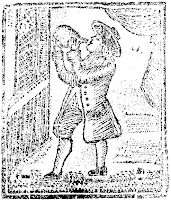“I snatch’d the golden glorious Opportunity”
In late July 1775, a Continental Congress delegate from Virginia named Benjamin Harrison (shown here, at least according to the federal government) wrote a letter to Gen. George Washington, an old acquaintance now commanding the American army outside Boston. He sent it north with a young Boston lawyer named Benjamin Hichborn, who was captured by the Royal Navy. (Someday I’ll tell that story in more detail.)
The British authorities in Boston had Harrison’s letter published in the 17 August Boston News-Letter, then being printed by Margaret Draper and John Howe. It was the only newspaper in town, and firmly in support of (and dependent on) the royal government.
Before Harrison’s letter saw print, someone inserted a few extra lines:
As I was in the pleasing Task of writing to you, a little Noise occasioned me to turn my Head round, and who should appear but pretty little Kate, the Washer-woman’s Daughter over the Way, clean, trim and rosey as the Morning; I snatch’d the golden glorious Opportunity, and but for the cursed Antidote to love, Sukey [Harrison’s wife], I had fitted her for my General against his Return. We were obliged to part, but not till we had contrived to meet again; if she keeps the Appointment I shall relish a Week’s longer stay.At least historians assume those lines were inserted because they don’t appear in copies of the letter that Gen. Thomas Gage sent to his superiors in the Secretary of State’s office in London. (Harrison’s original has not survived.)
Apparently a British “dirty tricks” artist wanted to smear Gen. Washington, and cause personal problems for him. As for Harrison, the aside might in fact have been in character for him; John Adams later described him as “another Sir John Falstaff,…his conversation disgusting to every man of delicacy or decorum.” If Harrison, back in Philadelphia, denied ever writing those lines, Adams probably didn’t believe him.
The copies of that letter sent to the Admiralty in London included the spurious lines. That’s yet more evidence of something we already knew: the British army and navy commanders didn’t get along during the siege of Boston. Gage and his staff didn’t give their naval counterparts copies of the original letter. Adm. Samuel Graves’s staff must have either received a doctored copy, or transcribed the text from the News-Letter.













